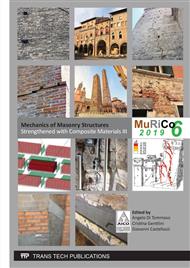p.3
p.9
p.15
p.23
p.30
p.37
p.44
p.50
Numerical Modelling of FRCM Materials Using Augmented-FEM
Abstract:
The use of externally-bonded composite materials for strengthening and rehabilitation of existing structures is among the most popular reinforcement techniques. Technologies, such as Fabric Reinforced Cementitious Matrix (FRCM) have been recently developed to address some of the issues of Fiber Reinforced Polymers (FRP), such as sensitivity to elevated temperatures and UV, impermeability, restricted application in presence of moisture or uneven substrate. For a detailed strengthening design with FRCM composites, the mechanical properties of the materials are required. Analytical models in literature discuss the interaction between the FRCM matrix and fabric using a fracture mechanics approach. These analytical laws were simplified using a trilinear curve in which a constant branch correlated to the friction is added. In the United States, “Acceptance Criteria AC434” includes the test methods to evaluate the mechanical properties of the FRCM through a direct tensile test which uses clevis grips. The material characterization per AC434 is in harmony with ACI 549.4R design guidelines. This study deals with the analysis of FRCM materials using 2D Augmented-Finite Element Method (A-FEM) approach. Constitutive material behaviors were used to implement on A-FE model, which can predict the failure modes of the composite material. The damage of the mortar was described by a trilinear curve, and the number and position of the cracks were fixed preliminarily. The fabric was modelled as a continuum layer attached to the mortar with no-thickness cohesive elements. The cohesive law between fabric and mortar was taken from the literature. The tensile test on the FRCM coupon with one layer of fabric was numerically modeled and compared to the experimental stress-strain curves. Results show that the numerical curves matched the experimental ones and capture the three branches of the FRCM constitutive law as well as the failure mode. This modelling tool will allow researchers to predict the constitutive law of an FRCM mater
Info:
Periodical:
Pages:
23-29
Citation:
Online since:
August 2019
Keywords:
Price:
Сopyright:
© 2019 Trans Tech Publications Ltd. All Rights Reserved
Share:
Citation:


